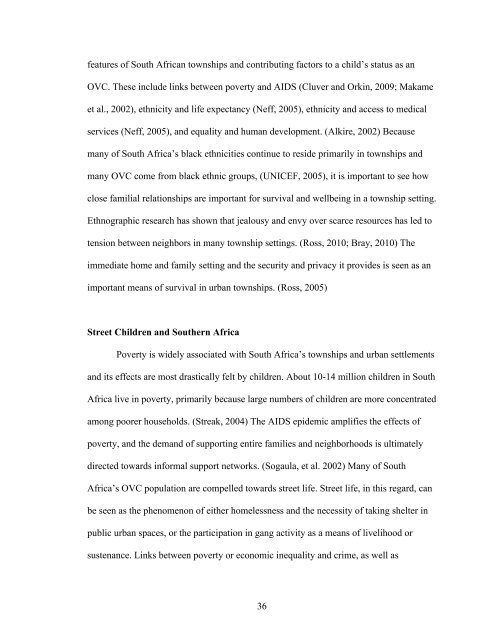INSTITUTIONALIZED CHILD CARE IN URBAN SOUTH AFRICA
You also want an ePaper? Increase the reach of your titles
YUMPU automatically turns print PDFs into web optimized ePapers that Google loves.
features of South African townships and contributing factors to a child’s status as an<br />
OVC. These include links between poverty and AIDS (Cluver and Orkin, 2009; Makame<br />
et al., 2002), ethnicity and life expectancy (Neff, 2005), ethnicity and access to medical<br />
services (Neff, 2005), and equality and human development. (Alkire, 2002) Because<br />
many of South Africa’s black ethnicities continue to reside primarily in townships and<br />
many OVC come from black ethnic groups, (UNICEF, 2005), it is important to see how<br />
close familial relationships are important for survival and wellbeing in a township setting.<br />
Ethnographic research has shown that jealousy and envy over scarce resources has led to<br />
tension between neighbors in many township settings. (Ross, 2010; Bray, 2010) The<br />
immediate home and family setting and the security and privacy it provides is seen as an<br />
important means of survival in urban townships. (Ross, 2005)<br />
Street Children and Southern Africa<br />
Poverty is widely associated with South Africa’s townships and urban settlements<br />
and its effects are most drastically felt by children. About 10-14 million children in South<br />
Africa live in poverty, primarily because large numbers of children are more concentrated<br />
among poorer households. (Streak, 2004) The AIDS epidemic amplifies the effects of<br />
poverty, and the demand of supporting entire families and neighborhoods is ultimately<br />
directed towards informal support networks. (Sogaula, et al. 2002) Many of South<br />
Africa’s OVC population are compelled towards street life. Street life, in this regard, can<br />
be seen as the phenomenon of either homelessness and the necessity of taking shelter in<br />
public urban spaces, or the participation in gang activity as a means of livelihood or<br />
sustenance. Links between poverty or economic inequality and crime, as well as<br />
36


